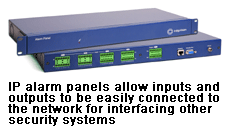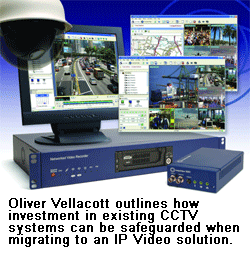Since the IP Video market has grown rapidly, it has been recognized as an evidently mature technology. IP networking of CCTV, access control and intruder alarms will gradually penetrate the majority of the market due to its versatile cost and performance advantages. But what does this mean for "legacy systems"? How can a business take full advantage of this emergent technology without casting away...
Since the IP Video market has grown rapidly, it has been recognized as an evidently mature technology. IP networking of CCTV, access control and intruder alarms will gradually penetrate the majority of the market due to its versatile cost and performance advantages. But what does this mean for "legacy systems"? How can a business take full advantage of this emergent technology without casting away existing investment in installed systems?
IP Video Technology
To get further into the points requires understanding the benefits of IP Video systems at the first place.
The advantages of IP Video can be highlighted by looking at the disadvantages  of analogue CCTV. Traditional coax or fiber based video systems are limited in many ways. Installation costs over large areas are prohibitive and the number of monitoring stations is limited due to the investment required to replicate costly switching infrastructure. The analogue matrix is the component that provides control room flexibility for analogue CCTV systems, but this too cannot be easily expanded without adding new hardware and it is location dependent. Therefore overall scalability is limited.
of analogue CCTV. Traditional coax or fiber based video systems are limited in many ways. Installation costs over large areas are prohibitive and the number of monitoring stations is limited due to the investment required to replicate costly switching infrastructure. The analogue matrix is the component that provides control room flexibility for analogue CCTV systems, but this too cannot be easily expanded without adding new hardware and it is location dependent. Therefore overall scalability is limited.
Even though the introduction of DVRs has improved the recording capabilities of analogue CCTV, these too are limited. They have to be physically installed near the analogue matrix, and frame rate and image quality is often compromised. Businesses want a single, scaleable, integrated solution which provides high-quality video surveillance across any number of their offices or sites and this is what IP Video delivers.
With an IP-based solution there is no need to worry that any future expansion will reach the capacity limit of the installed hardware, since additional devices, such as cameras, monitoring stations and video recorders, can be incorporated at any point on the network at any time. The latest IP Video systems use advanced compression technologies that enable DVD-quality digital video, with low latency, that is indistinguishable from traditional analogue.
The extent to which a business might want to change to IP Video is dependent upon the application, but typically it will be when additional cameras, monitoring stations or recording capacity is required for an existing system, or when a number of systems on different sites are to be merged.
Planning the Migration
It is important to involve the IT department at an early stage in the planning process. Competent IP Video products now feature much of the functionality with which IT professionals will be familiar, such as SNMP (Simple Network Management Protocol) for management purposes, integral firewalls, bitrate capping and diagnostic programs. These all ensure that the IT team can maintain full control over the network traffic generated and monitor system performance, and to simplify troubleshooting should difficulties arise.
A properly planned migration is best undertaken in phases. These can be  contiguous or as demand and budget allows, thereby allowing for each phase to be "proven" before moving to the next. This has the additional benefit that older equipment can be retained and fully utilized until continuing support for it becomes costly or otherwise impractical. The migration process can be stopped or delayed at any point and the system continued with a hybrid setup.
contiguous or as demand and budget allows, thereby allowing for each phase to be "proven" before moving to the next. This has the additional benefit that older equipment can be retained and fully utilized until continuing support for it becomes costly or otherwise impractical. The migration process can be stopped or delayed at any point and the system continued with a hybrid setup.
Looking from a Hypothetical Example
Following provides a hypothetical example for more thorough understanding. A system on a site has a mixture of 150 cameras, both static and PTZ. It has an OCC (Operational Control Centre) with two operators and is conventionally equipped with a hardware switching matrix with Digital Video Recorders (DVRs) continuously recording all cameras.
The system needs to be expanded, and the following requirements have been drawn up:
50 cameras need to be added to the existing system
a monitoring point in the OCC needs to be installed for a further operator
two of the organisationˇs managers want live views of selected cameras at their desks
some additional security measures need to be installed at the car park 500m away
The site has an existing corporate LAN (Local Area Network).
The available budget doesnˇt allow the user to throw away the existing system, so any savings that can be made will be important. The hypothetical project will be broken down into three phases.
Phase 1: Main Site
Because of budget constraints the existing matrix, operator stations and DVRs  will be retained. Savings will be made by connecting new cameras into the system using the existing LAN rather than running dedicated co-axial and PTZ cabling from the matrix out to each camera location.
will be retained. Savings will be made by connecting new cameras into the system using the existing LAN rather than running dedicated co-axial and PTZ cabling from the matrix out to each camera location.
Using IP Transmitters (encoders) will allow complete freedom of camera choice. Any conventional camera from any manufacturer at any location will work well. The additional cameras will be connected into the LAN via a transmitter, and the corresponding IP Receivers (decoders) for each camera will be connected to unused matrix inputs at the OCC.
The matrix outputs will be connected to further IP Transmitters putting the existing OCC video feeds on to the LAN. PCs with monitoring software for the additional operator in the OCC and for the desk PCs of the two managers will be added. The system will be configured to restrict access ensuring that the managers are only able to access the cameras that they are authorized to view.
The additional cameras will need an expanded recording capability. Networked Video Recorders (NVRs) will be added to the network to meet this requirement. Since this element, like all the others in an IP solution, is totally scaleable it frees the user from the constraints of simply expanding the existing DVRs. Using NVRs gives the user access to recorded video from anywhere on the network.
Phase 2: Car Park
IP cameras, help points, lighting controls and a barrier with a speech unit for visitors will be installed providing additional security measures for the car park. In addition access control for employees will be introduced, which is capable of being remotely operated or overridden from the OCC. To save on cabling costs and to get across the approach road a small, secure 5.8GHz wireless network will be used to connect all of these devices across to the main building and to extend the LAN. All devices and functionality will be controllable from the OCC, and from the same PC software used for monitoring.

Phase 3: Full IP Solution
The project has made full use of the original CCTV equipment up to this point but when budgets become available migration to a full IP system can occur. This is justified on the basis that the maintenance of the matrix becomes more problematic with age, the recording capacity of the DVRs becomes increasingly inadequate and the user sees the many operational benefits from the developing IP Video system.
The original hardware matrix will now be removed, with the LAN and monitoring software becoming the so called virtual matrix. An IP Transmitter will be installed to each of the original cameras making them IP compatible. As the cameras are already cabled back to a common point at the main OCC, rack mounted IP Transmitters will be used, resulting in a typical cost saving of 10-15% over standalone units. The IP Transmitters and Receivers connected directly into the matrix will be reused to connect some of the analogue cameras to the network.
Summary
This example shows how easy it is to migrate an existing analogue system to an IP solution. Even though it is hypothetical it is very typical of many applications. For example, London Luton Airport phased their migration to a pure IP system, via various hybrid combinations, over a period of three years. IP Video is obviously suited to large mission critical applications, as in the last two Olympic Games, but smaller systems can also benefit. The progressive nature of the migration allows existing budget constraints to be accommodated and allows each phase of the project to be thoroughly tested. This gives the user confidence that IP based security will meet the project requirements. Overall costs are kept to a minimum because significant parts of the existing CCTV infrastructure are re-used and future expansions can easily and inexpensively be added.